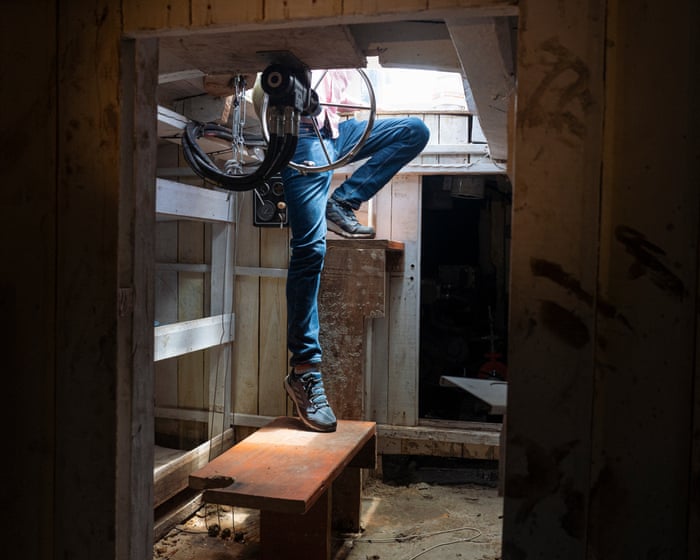The physical and mental challenges have been immense, with countless setbacks along the way. Miriam Payne and Jess Rowe have endured scorching days and cold nights, battling painful blisters and salt sores. They’ve faced multiple equipment failures—even using a pair of underwear to fix a crucial piece of gear—and had a tense moment when curious marlins swimming beneath their boat threatened to puncture the hull.
Now two-thirds of the way through their 8,000-mile row across the Pacific from Peru to Australia, the pair are exhausted but still savoring the experience. Speaking to the Guardian via satellite phone during a dawn shift change—they alternate two hours on, two off at night—Rowe admitted, “I’m very tired, I won’t lie. Waking up for your shift is so hard. We don’t even hear our alarms anymore—they ring for 10 or 15 minutes, and then the person rowing has to wake the other. It’s tough. But aside from the lack of sleep, we’re loving it.”
Rowe, 28 from Hampshire, and Payne, 26 from East Yorkshire, are both experienced Atlantic rowers. They met at the Blue Marlin bar in La Gomera, a gathering spot for ocean adventurers in the Canary Islands, where they hatched their plan to take on the Pacific. If successful, they will be the first all-women team and the first pair to row the Pacific non-stop and without support.
After more than 100 days at sea, they estimate about 60 remain. Rowe said, “We’ve reached the point where the distance left is similar to an Atlantic row. Since we’ve both done that before, we tell ourselves, ‘It’s okay—we’ve just got an Atlantic left.'”
Contrary to expectations of constant storms and towering waves, they’ve found the Pacific surprisingly calm at times. Rowe described rowing as meditative, falling into a rhythm while surrounded by stunning 360-degree views, starry nights, and breathtaking sunsets.
Preparations for the journey took months, from finding and refurbishing their 30-foot boat, Velocity, to vacuum-packing hundreds of meals. Nutrition is critical—they need 5,000 calories a day—and they deeply miss fresh fruits and vegetables, craving mangoes and carrots after growing tired of freeze-dried food.
Power has also been a challenge. Solar panels provide some energy, but they once had to use Calvin Klein underwear to replace a lost filter on their freshwater maker. Reliable power and fresh water are among the things they most look forward to on land.
Despite the hardships, the two get along well. Rowe noted, “You can prepare and spend time together beforehand, but you never know what will happen out here. Luckily, we’re both pretty relaxed. We listen to each other and are already planning a holiday together after this.”Our website is protected by Google reCAPTCHA, and the Google Privacy Policy and Terms of Service apply.
After the newsletter promotion:
Every four days, the pair jump into the water to clean the boat’s hull, keeping it as streamlined as possible. They actually look forward to these swims—it’s their best chance to stretch out. Afterward, they rinse off with fresh water and put on clean clothes, which feels like a real luxury. There’s no toilet on board; they use a bucket and toss it overboard.
Along with marlins, they’ve seen a sperm whale and plenty of shark fins. They also had a hitchhiker join them—a masked booby seabird, likely from the Galápagos Islands—and they never tire of watching the glowing phosphorescence in the boat’s wake.
The two are raising money for the Outward Bound Trust and have no idea what’s been happening in the world since they set out. Payne said, “It’s actually quite nice. It always seems to be bad news, especially these last few years. Sometimes you do wonder what’s going on, but it’s refreshing to have a digital detox and be completely disconnected.”
She’s looking forward to walking on dry land again. “The muscles you use for walking have weakened a bit. It’ll be nice to move differently, but we’re still strong.”
When asked how they keep going, Payne said they really have no choice. “If we stop rowing, we’ll just drift aimlessly. You have to keep rowing to survive, so we just keep plodding along.”
Frequently Asked Questions
Of course Here is a list of FAQs about the UK duos charity row designed to be clear and helpful
General Beginner Questions
Q Who are Were just keeping going
A They are a UKbased duo James Cash and Oliver DaweLane who are attempting to row 8000 miles across the Atlantic and Pacific Oceans for charity
Q What is their goal
A Their primary goal is to complete this incredible 8000mile journey to raise money and awareness for two charities The British Red Cross and The AHOY Centre
Q How far have they gotten so far
A They have successfully completed the Atlantic crossing and are now over twothirds of the way through their entire 8000mile challenge
Q How long is 8000 miles
A Its an enormous distance For perspective its roughly the equivalent of rowing from London to Mumbai and back again
Q Which charities are they supporting
A They are raising funds for The British Red Cross and The AHOY Centre a charity that uses sailing and rowing to help disadvantaged young people
Q How can I donate to their cause
A You can donate through their official fundraising page A simple online search for Were just keeping going donation should direct you to the correct platform
Advanced Detailed Questions
Q What route are they taking
A Their journey is split into two massive legs first rowing across the Atlantic Ocean and then rowing across the Pacific Ocean from California to Hawaii
Q How do they handle food water and sleep on the boat
A They carry all their food and have a watermaker that turns seawater into drinkable water They sleep in short shifts ensuring someone is always awake to row and keep watch
Q What are the biggest dangers they face at sea
A They face numerous hazards including massive storms huge waves potential collisions with large ships extreme fatigue and physical injuries from the constant rowing
Q What kind of boat are they using
A They are rowing a specialized oceangoing rowboat Its designed to be selfrighting if it capsizes and has a small cabin




